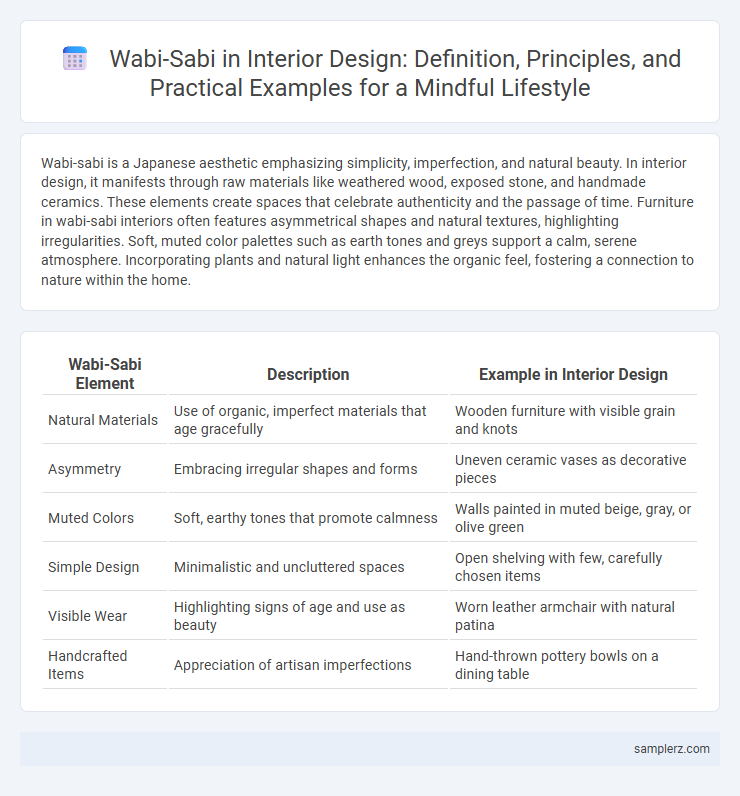Wabi-sabi is a Japanese aesthetic emphasizing simplicity, imperfection, and natural beauty. In interior design, it manifests through raw materials like weathered wood, exposed stone, and handmade ceramics. These elements create spaces that celebrate authenticity and the passage of time. Furniture in wabi-sabi interiors often features asymmetrical shapes and natural textures, highlighting irregularities. Soft, muted color palettes such as earth tones and greys support a calm, serene atmosphere. Incorporating plants and natural light enhances the organic feel, fostering a connection to nature within the home.
Table of Comparison
| Wabi-Sabi Element | Description | Example in Interior Design |
|---|---|---|
| Natural Materials | Use of organic, imperfect materials that age gracefully | Wooden furniture with visible grain and knots |
| Asymmetry | Embracing irregular shapes and forms | Uneven ceramic vases as decorative pieces |
| Muted Colors | Soft, earthy tones that promote calmness | Walls painted in muted beige, gray, or olive green |
| Simple Design | Minimalistic and uncluttered spaces | Open shelving with few, carefully chosen items |
| Visible Wear | Highlighting signs of age and use as beauty | Worn leather armchair with natural patina |
| Handcrafted Items | Appreciation of artisan imperfections | Hand-thrown pottery bowls on a dining table |
Embracing Imperfection: Key Principles of Wabi-Sabi in Interior Design
Wabi-sabi in interior design celebrates natural materials such as unfinished wood, stone, and handmade ceramics that highlight organic textures and irregularities. Embracing imperfection involves incorporating asymmetrical shapes, weathered finishes, and muted earth tones, creating a tranquil, authentic space. This philosophy values simplicity and the beauty found in aging, encouraging spaces that feel lived-in and deeply connected to nature.
Natural Materials: Celebrating Raw Textures at Home
Natural materials such as untreated wood, stone, and linen embody the wabi-sabi philosophy by highlighting raw textures and organic imperfections in interior design. Exposed wooden beams and weathered stone surfaces create an earthy ambiance that emphasizes simplicity and authenticity. Incorporating plants and natural fibers adds warmth while celebrating the inherent beauty found in nature's imperfections.
Earthy Color Palettes: Muted Tones for Calm Spaces
Wabi-sabi interior design embraces earthy color palettes featuring muted tones such as soft browns, mossy greens, and warm grays to create calm and grounded spaces. These natural hues evoke simplicity and tranquility, reflecting the beauty of imperfection and the passage of time. Incorporating raw materials like weathered wood and textured ceramics enhances the serene ambiance characteristic of wabi-sabi aesthetics.
Minimalist Furnishings: Choosing Quality Over Quantity
Minimalist furnishings in wabi-sabi interiors emphasize quality over quantity by selecting handcrafted wooden pieces with natural imperfections that highlight authenticity and simplicity. The focus on functional design paired with muted earth tones creates a serene, uncluttered living space that celebrates impermanence and understated beauty. This approach fosters a calming atmosphere, encouraging mindfulness and appreciation of craftsmanship in everyday surroundings.
Handmade Decor: Unique Pieces with Personal Stories
Handmade decor embodies the wabi-sabi philosophy by celebrating imperfections and the natural beauty of materials, creating unique pieces with rich personal stories. Items such as hand-thrown ceramic vases, handwoven textiles, and reclaimed wood furniture enhance interiors by adding warmth and authenticity. Each handcrafted element reflects individual craftsmanship, fostering a sense of tranquility and connection to the past in living spaces.
Weathered Surfaces: The Beauty of Aging and Patina
Weathered surfaces in interior design highlight the wabi-sabi philosophy by embracing the natural aging process of materials like wood, metal, and stone, showcasing their unique patina. This aesthetic values imperfections and irregularities, which tell a story of time and use, creating a warm, authentic atmosphere. Incorporating vintage furniture, distressed finishes, and rusted accents brings depth and character, celebrating impermanence and the beauty of imperfection.
Organic Shapes: Soft, Unrefined Lines in Furniture and Objects
Organic shapes with soft, unrefined lines in furniture and objects exemplify the wabi-sabi aesthetic by embracing natural imperfections and simplicity. Materials like hand-carved wood, uneven ceramics, and irregular textiles highlight the beauty found in imperfection and impermanence. These elements create a calming, authentic atmosphere that fosters mindfulness and connection to nature in interior spaces.
Serene Lighting: Creating a Tranquil Atmosphere with Subtle Illumination
Serene lighting in wabi-sabi interiors emphasizes soft, natural light that enhances imperfections and texture, fostering a calm and peaceful atmosphere. Using paper lanterns, rice paper lampshades, or warm LED bulbs creates subtle illumination that highlights rustic wood, handmade pottery, and organic materials. This gentle lighting approach complements the minimalist aesthetic, inviting relaxation and mindfulness.
Functional Simplicity: Streamlining Spaces for Peace
Incorporating wabi-sabi in interior design emphasizes functional simplicity by decluttering spaces and embracing natural, unpretentious materials like raw wood and textured ceramics. This approach promotes tranquility through minimalism, where each piece serves a purpose without excess decoration, enhancing the room's peaceful ambiance. Thoughtful furniture placement and muted earth tones further streamline the environment, creating a harmonious, calming living space.
Nature Indoors: Integrating Plants and Natural Elements
Incorporating wabi-sabi in interior design emphasizes the beauty of imperfection and natural simplicity by integrating plants, raw wood, and stone elements. Potted moss, ceramic vases with subtle glazing, and weathered wooden furniture create a tranquil atmosphere that reflects nature's organic textures and asymmetry. Bringing natural light and airiness into spaces enhances the calming, mindful experience central to the wabi-sabi lifestyle.

example of wabi-sabi in interior Infographic
 samplerz.com
samplerz.com